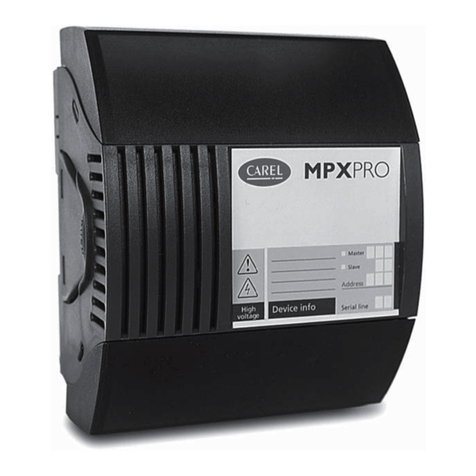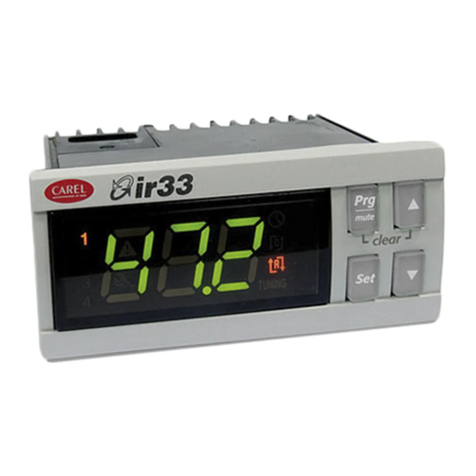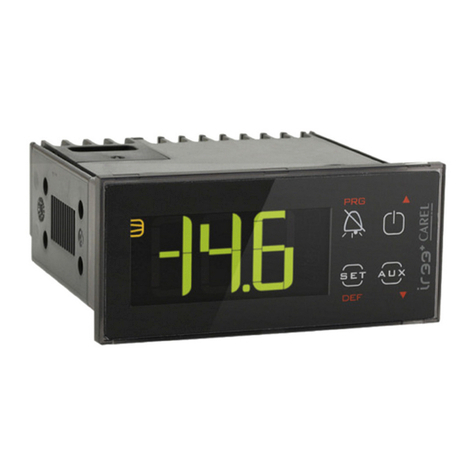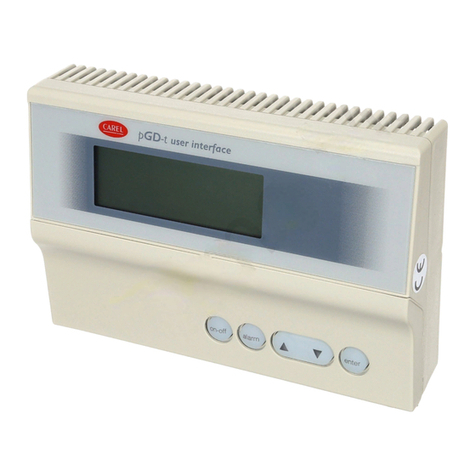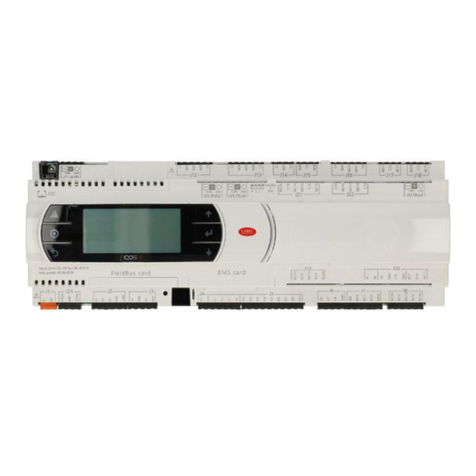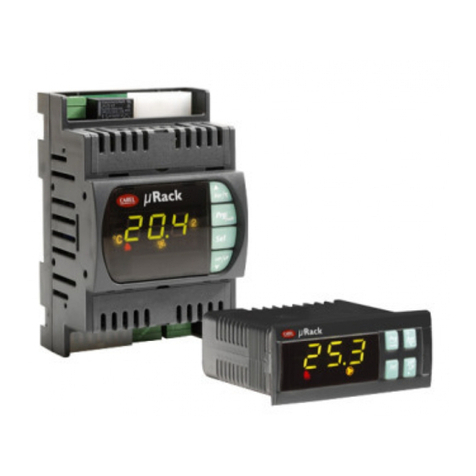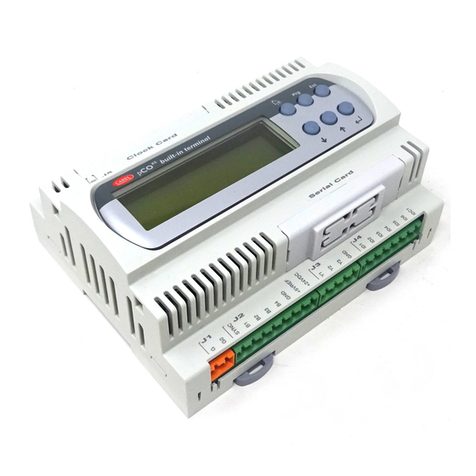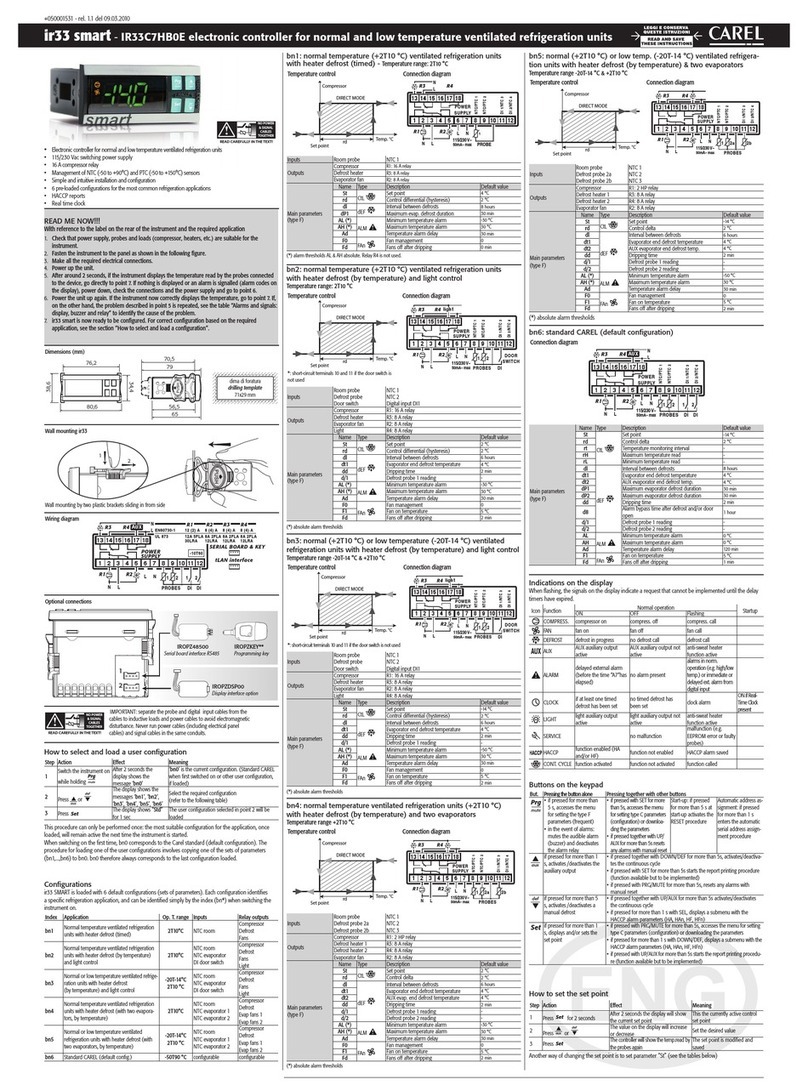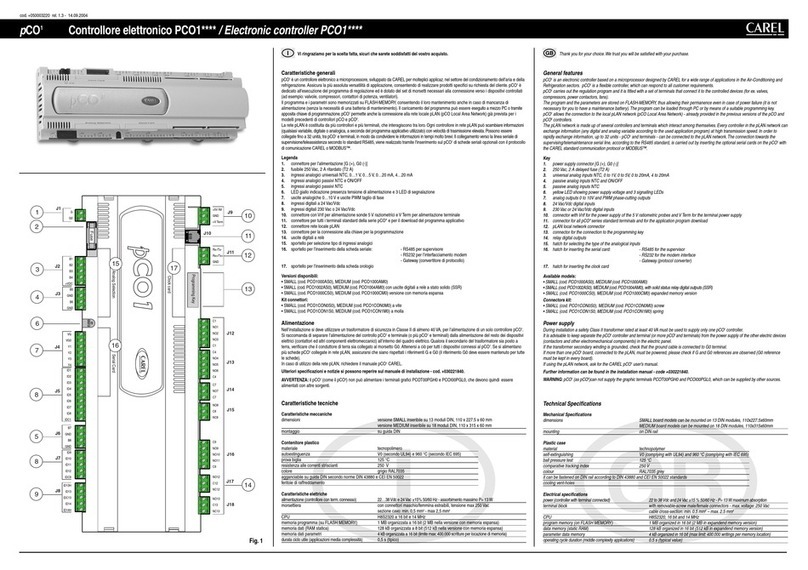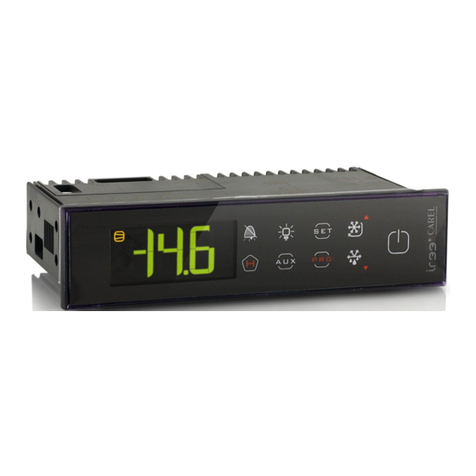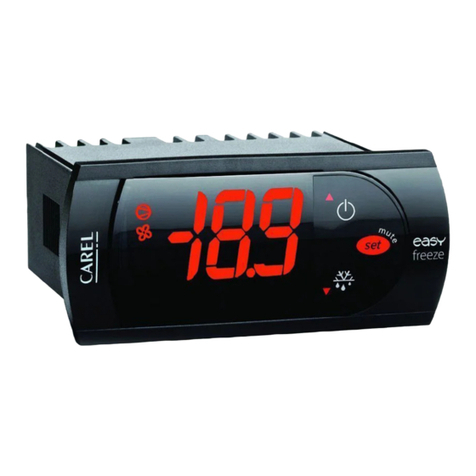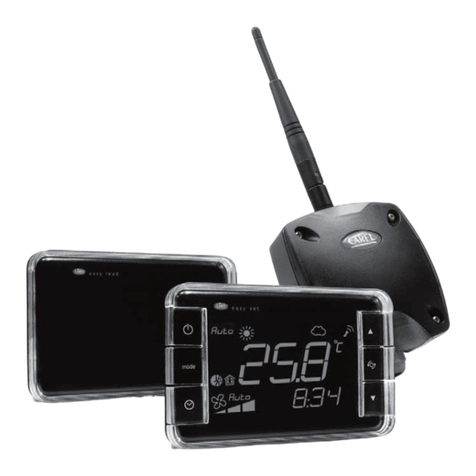
General characteristics
The MCHRTF10C0 electronic device is single-phase voltage controller that use the principle
of phase control to adjust the effective voltage output to the load, based on the phase of the
PWM control signal (see Fig. 3, which refers to the case of a resistive load).
One typical application is the speed control of single-phase condenser fan motors, based on
the pressure or the temperature measured on the heat exchanger.
The MCHRTF10C0 controllers are protected against short circuits by a fuse located on the
outside of the board, thus allowing easy inspection and replacement, where necessary (refer to
Table 3 for the correct replacement of the fuse). Always check with the manufacturers that the
motors used are suitable for operation with phase control devices.
Assembling the controller in the panel
The controller is mounted using plastic spacers (supplied), to be inserted in the four holes on
the board. To optimise the dissipation of the heat produced, the device should be installed
in environments where the temperature does not exceed 50 °C and there is sufficient air
circulation.
The installer must guarantee the safety of the device.
Electrical connections
The controller should be connected as illustrated in Fig. 2. The speed controller must be
connected to the control device as follows:
• Install a safety disconnecting switch upstream on the supply line (230 Vac) so as to be able
to isolate the device for inspection.
• Connect the power supply (230 Vac) to terminals L and N. Connect the fan motor to the
terminals marked LOAD.
• Before powering up the controller, check the power connections and make sure the earth
connection is correct.
• For the power connections and the earth wire, use cables with the cross-section shown in the
table of technical specifications (Tab 1).
• The PWM control signal is applied to terminals +/- of the device.
• For the PWM control signal, use a shielded cable with a maximum length of 5 m, and keep
the cable separate from other power cables.
• The power supply to the controller and the fan speed control board must be in phase. If, for
example, the power supply is three-phase, make sure that the primary of the power
transformer on the control board is connected to the same phase as terminals L and N on
the speed control board or boards; consequently, do not use 400 Vac / 24 Vac transformers
to supply the controller if phase and neutral are used to directly power the speed control
boards.
Commissioning
After having checked the connections, power up the board and apply the PWM signal from
the controller: when displacement changes compared to the mains, the effective voltage at the
controller output will vary from 0 to 230 V. In the case of resistive loads and a mains frequency
of 50 Hz, the input/output characteristic is shown in Fig. 4: the x-coordinate represents the
displacement, while the y-coordinate indicates the effective voltage supplied at the output to
the load.
MCHRTF10C0 - Regolatore di velocità monofase versione base/Basic version single phase fan speed controller
+050002925 - rel. 1.1 del 23.01.2007
Caratteristiche generali
Il dispositivo MCHRTF10C0 è un regolatore di tensione monofase che utilizza il principio del
taglio di fase per regolare la tensione efficace in uscita al carico, in base alla fase del segnale
PWM di comando (vedi Fig. 3, che si riferisce al caso di carico resistivo).
Una tipica applicazione è quella della regolazione di velocità dei motori dei ventilatori monofase
di condensazione, in base alla pressione o alla temperatura misurata sullo scambiatore stesso.
Il regolatore MCHRTF10C0 sono protetti da cortocircuito per mezzo di un fusibile posto sulla
parte esterna della scheda, in modo da poter essere facilmente ispezionato e, se necessario,
facilmente sostituito (riferirsi alla Tab. 3 per la corretta sostituzione). Si raccomanda di verificare
con i costruttori che i motori utilizzati siano idonei all’utilizzo con la regolazione a taglio di fase.
Montaggio del regolatore nel quadro
Il regolatore è montato mediante distanziali plastici (forniti in dotazione) da inserire nei relativi
quattro fori della scheda. È consigliabile, per ottimizzare lo smaltimento di calore prodotto,
installare l’apparecchiatura in ambienti in cui la temperatura non superi i 50 °C e vi sia una
sufficiente circolazione d’aria.
E’ a cura dell’installatore la messa in sicurezza dell’apparecchiatura.
Collegamenti elettrici
Il regolatore va collegato come illustrato in Fig. 2. Il regolatore di velocità deve essere abbinato
al controllo facendo attenzione a quanto segue:
• Predisporre un sezionatore di sicurezza a monte dell’alimentazione (230 Vac) in prossimità
dell’apparecchio, in modo da poterla interrompere per eventuali ispezioni.
• Collegare l’alimentazione (230 Vac) ai morsetti L e N. Collegare il motore del ventilatore ai
morsetti LOAD.
• Prima di alimentare il regolatore, controllare le connessioni di potenza e verificare l’efficienza
della connessione verso terra.
• Per le connessioni di potenza e il cavo di terra, utilizzare cavi aventi la sezione riportata nella
tabella delle caratteristiche tecniche (Tab. 1).
• Il segnale di comando a modulazione di impulsi (PWM) viene applicato sui morsetti +/- del
dispositivo.
• Per il segnale di comando PWM, utilizzare un cavo di lunghezza massima 5 m, e tenere
separato il cavo da altri cavi di potenza.
• Le alimentazioni del controllo e della scheda parzializzazione ventilatori devono essere in
fase; ad esempio nel caso di alimentazione trifase del sistema, assicurarsi che il primario
del trasformatore di alimentazione della scheda del controllo sia allacciato alla stessa fase
collegata ai morsetti L e N della o delle schede di regolazione di velocità; non utilizzare quindi
trasformatori 400 Vac / 24 Vac per l’alimentazione del controllo qualora si utilizzino fase e
neutro per alimentare direttamente le schede di regolazione velocità.
Messa in servizio
Dopo aver verificato i collegamenti, alimentare la scheda e applicare il segnale PWM
proveniente dal controllo: al variare del suo sfasamento rispetto alla tensione di rete, la tensione
efficace in uscita dal regolatore varia da 0 a 230 V. Nel caso di carico resistivo e frequenza di rete
50 Hz, la caratteristica ingresso/uscita è riportata in Fig. 4: in ascissa è indicato lo sfasamento,
mentre in ordinata è indicata la tensione efficace fornita in uscita al carico.
Dimensioni (mm)/Dimensions (mm)
64
74.5
90
1950
84
15
29.535.519
12.53
74.5 12.53
Ø 4
Fig. 1
